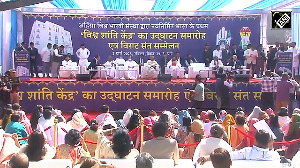The Reserve Bank of India today announced a fresh set of measures to infuse more liquidity into the financial system to encourage banks to resume normal lending.
Quick in the RBI's wake, IDBI Bank announced a reduction of 50 basis points - one basis point equals one-hundredth of a percentage point - in the interest rate charged on home and education loans. Some other banks said they might follow suit.
On a day that China finally admitted to feeling a slowdown, the RBI announced a reduction in the cash reserve ratio, or CRR, the repo rate, and the statutory liquidity ratio, or SLR.
In addition, it opened a special window for banks to raise resources, which can be used to on-lend to non-banking finance companies, or NBFCs.
SLR, which is the proportion of liabilities that banks invest in approved securities like government bonds, has been lowered to 24 per cent from 25 per cent earlier. On September 16, an ad-hoc relaxation in SLR was announced. It has been regularised.
Along with the government, the RBI will finalise a scheme to buy back market stabilisation scheme bonds to inject liquidity. The central bank issues MSS bonds on behalf of the Centre to mop up liquidity generated through high foreign capital flows. As on October 24, the outstanding MSS bonds were estimated at Rs 1,65,187 crore (Rs 1,651.87 billion).
With heavy outflows of the dollar due to foreign institutional investors, or FIIs, fleeing the Indian markets, the RBI and the government will calibrate the buy-back in a way that it is in line with the Centre's borrowing programme. The move will help in reducing government borrowings, which suck out liquidity.
The reduction in CRR, or the proportion of deposits that banks park with the RBI, in two stages of 50 basis points each will release Rs 40,000 crore (Rs 400 billion) into the system. The SLR cut can release another Rs 40,000 crore, while another Rs 60,000 crore (Rs 600 billion) may come into the system if banks use the special window to lend to NBFCs.
A special refinance window has also been opened for scheduled commercial banks through which they can access an additional Rs 35,000 crore (Rs 350 billion) from the RBI for up to 90 days.
The reduction in the repo rate - the rate at which the RBI lends to banks - indicates a softening of the interest rate regime. The CRR cut infuses liquidity into the system and reduces the cost of funds, since the money placed with the Central bank does not earn any interest.
When the RBI had cut the repo rate by 100 basis points last month, banks did not lower their rates, neither on deposits nor on loans. The steps taken by the RBI earlier had released Rs 1,85,000 crore (Rs 1,850 billion) into the system, but a large part of it was sucked out due to its intervention in the foreign exchange to shore up the falling rupee, an activity that the Central bank intends to continue. On Friday, call rates rose to 21 per cent and banks borrowed over Rs 65,000 crore (Rs 650 billion) from the RBI as the liquidity situation tightened again.
Some of today's moves, which come barely a week after the mid-term review of the annual policy statement, or the credit policy, are the outcome of recommendations made by the liquidity adjustment and injection committee headed by Finance Secretary Arun Ramanathan.
Banks other than IDBI Bank were non-committal today. A clearer picture on whether they would indeed prune lending and deposit rates will emerge after public sector bank chiefs meet Finance Minister P Chidambaram on Tuesday.
"It may take up to a month to see prime lending rates fall, as banks will need to raise resources for credit limits that have already been sanctioned," said Bank of India chairman T S Narayanasami. He indicated that the extent of the PLR cut could be up to 50 basis points.
Neeraj Swaroop, Standard Chartered Regional CEO, India and South Asia, said: "The rate cuts are signaling pro-growth effort by the RBI. We will wait and watch for a week to take a call on our lending and deposit rates, but the possibility is more of a downward revision."
An Axis Bank executive said the bank would decide on interest rates in the next seven to 10 days.
Union Bank of India chairman & managing director MV Nair said his bank would decide on a rate cut of up to 50 basis points over the next two weeks. "The actual benefit passed on to customers will not be in the same as the repo rate cut, since the cost of funds only declines gradually, while the interest income dips immediately after a reduction in the lending rates," he added.
The country's second largest lender, ICICI Bank, was more cautious. Its joint managing director & chief financial officer, Chanda Kochhar, said: "It will have a cooling effect on the call rates. But we will have to wait to assess the impact on the lending and deposit rates."
Punjab National Bank, which yesterday announced a 50 basis points reduction in its prime lending rate, today said it would watch the liquidity situation and the moves by other banks before taking further measures.






 © 2025
© 2025